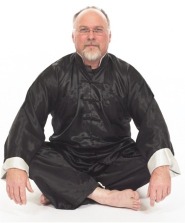I have been considering development of skill and how that accumulates with age – once you learn to ride a bike do you ever forget? Swimming, playing a musical instrument, in fact any skill once learned seems never forgotten. If not practiced we lose some measure perhaps but once a skill is acquired a little practice goes a long way. Tai Chi is the same, put in the work to learn it to a reasonable level then you can keep improving well into old age because it is largely dependent on our ability to pay attention and to feedback into an embodied skill.
Hysteria vs reality – our current viral pandemic reminds me somewhat of those online viruses where the message itself is the virus and we all get panicked thinking that there is a danger we cannot see. The same is true of Tai Chi where our own worst enemy is our fight, flight, freeze reaction which can achieve comparable levels of hysteria in the individual to those we see writ large around the globe in whole populations, fueled by lack of attention to understanding reality.
I have lost count of the number of times that a student has said – “but I am doing what you said” – which is actually quite rude when I can clearly see that they are not – and of course it can easily become an argument after that, so the teacher maybe tries another approach and getting the same negative response, demonstrates again and leaves the matter until later when the student is ready.
I know this is a problem because I fall into it myself but have long ago stopped claiming that I am doing what I have been told – many sessions of golf lessons with video really pushed that home, the video shows that we think we are doing something one way but we are not, we are doing it quite differently – although truth to tell I have always respected my teachers too much to tell them that they are wrong, preferring instead to say “I thought I was doing what you said” or ” that is what I was trying to do” or similar before going off to look in my own practice for whatever it was they were trying to show me.
Recently working in push hands with my teacher Karel he said “now push”, at first it was so awkward that I could not – but then I tried something different and it was easy – I had “discovered” something which all my teachers had always tried to explain but which I had never to that point actually understood in the way that I needed to. It was not the “fault” of my teachers – they could “do it” and all were trying their very best to transmit what they knew – it was my fault for not understanding. Ultimately many hours of training and experimenting paid off and I did finally understand. And now looking back – I cannot think of a better way to explain it than the way they used, my inner voice exclaimed “ah so that is what they meant!” and now having found it I have only the same language that they used. Although in my own teaching I can now demonstrate it better – but can the students see the difference – I could not.
But having found it once does not mean there is not more for me to understand and I will probably need to re-discover the same thing many more times.
Tai Chi seems to be something that “you can’t do it until you can – then you can”
Practicing Tai Chi on your own
12/04/2020We often associate meditation – especially Buddhist mind emptying – with Tai Chi and now when we are forced to practice on our own it is a good opportunity to explore meditation as an aid to our movement.
Let us consider for a moment watching the birds in our garden or lemurs on a nature program – do they think analytically/intellectually/consciously about how they fly between the branches or swing from one to another? Our conscious mind is a great advantage when we have the time to use it but when negotiating branches or when enmeshed in a fight we simply do not have time for conscious thought – we need to release ourselves from our consciousness simply in order to do some things at all.
If the ape considered carefully whether the next jump was possible it would simply be too late and they would probably get it wrong.
The time for conscious thought is in exploring carefully – like doing lots of training runs before going for the best possible version.
So with that in mind let us by all means practice at a glacially slow pace – but then occasionally speed up and practice fast – fast enough so that your conscious mind cannot keep up – and then go faster to find out where your movement breaks down.
Using the form as a learning tool
11/04/2020When practicing your form – whatever style and however long – it is important to consider how you practice – there are many ways. We can think of the form as a training in itself with all the benefits of slow movement, but it is also a structure from which we can learn. You may be used to the idea of noticing problems in your form and probably being corrected by your teacher – it is important to take these observations and corrections further – simply by looking at the small part of the form and then at the components of the movement. Perhaps there is a point where a problem has been noticed, then it is worth isolating that movement to study and experiment with different options until finding a better way and then re-integrating. This process may take a day or it may take months or years, so focusing on relaxing and aligning wrists for example in silk reeling, plays into normal daily practice of the form.
Then identify something else and work on that – it may be a physical thing or it may be an emotional or mental thing like wu wei – effortless action, using mind not strength.
Question everything – you may have been doing something crucially wrong for years – despite the best efforts of your teacher. It is surprisingly easy to learn something ten years ago and never question our understanding of it, only to find that 10 years ago we didn’t understand.
Free sessions for existing students
07/04/2020I am deriving great benefit from my own personal practice in my garden – and am missing my usual students – what can I say Tai Chi is paradoxical!
Now I know that Zoom is all the rage for classes at the moment but while it clearly helps beginners with motivation and engagement – I am not keen for a variety of reasons. I have always taken the view that I would like to encourage those committed students in their regular practice and have set up the high level of discount on 10 week packages in order to do exactly that.
Consequently I would now like to offer my existing students only – from any of my classes – discretionary and free one-to-one video consultations – just contact me to arrange a video call.
You know who you are so I look forward to hearing from you on 07860 218334 or by e-mail
All the best
Ian
Training on your own
05/04/2020Some simple training tips I have found useful:
- Pick a part of your body to focus on – legs, arms, hips, shoulders or whatever then do your exercises and form while focusing on them trying to keep that part 50% relaxed. Then do the same while working with your lower abdomen – tantien.
- Read a good book on Tai Chi eg Master Chen Xiaowang’s “Five Levels of Tai Chi” or his coffee table “Chen Family Taijiquan” perhaps the “Tai Chi classics” which I think can be found for free online. Pick a part which seems to resonate with you and then focus your practice on understanding that particular part by recognising what they are saying from the feelings in your body. Repeat as necessary.
- Watch videos by good practitioners in an attentive manner – seek to understand what they are doing
Good luck
This came up in conversation recently with my teacher Karel Koskuba in discussing how one progresses in Tai Chi – this constant process of practicing and noticing – paying attention to small things and following them – until suddenly there is a realisation of significant change and that something previously impossible is now relaxed, natural – almost easy.
A process which seemingly continues in successive cycles……………….until it doesn’t.
Changing direction in Tai Chi practice
30/03/2020When I practice alone I have the freedom to work without a teacher – that is to say without anybody actively correcting me – I have the freedom to make mistakes and to try “the wrong ” way of doing and sometimes this really pays off. Because I paid attention at the time all my teachers and lessons are memorised inside me and by going “off piste” I am not questioning them but rather I am questioning my original interpretation of what I thought they were saying or doing – it is amazing how often I got it wrong all those years ago and now suddenly realise what it was they were really trying to teach.
What can I say I am a slow learner!
I find it a bit like being lost without realising it because everything is so familiar, so habitual, in such a comfortable rut – I need to look around and try a new direction in order to find the right path again. We all get delusional sometimes and just doing the same old thing yields the same results – which generally can be a good thing but we can easily veer off in without realising it so it can be worth shaking yourself up and trying some different things. Remember the lesson and try to look for different possibilities than the one you have been focusing on.
The snowglobe of life needs shaking up occasionally so it can settle into a new pattern.
Enforced practice!
26/03/2020Well with all this working from home I find that the urge to go outside in our garden occurs a few times a day – often to sit with a coffee, but increasingly to do a Tai Chi form maybe 2 or three times a day – which means about one to one and a half hours a day of practice. We are lucky to have quite a large area of lawn but I am really only using a patch about 20 feet by 10 – which is getting very trampled – so not so much grass to cut then!
Working on my own I can go at whatever speed I like – and that is getting slower and slower – and co-incidentally lower and lower.
So my practice has taken on a sort of “do it when I feel like it” routine and I am enjoying it that way – and finding more and easier movement in some unexpected places.
Good luck with your own “enforced” practice and I hope you are all well – I look forward to seeing you when we come out the other side.





